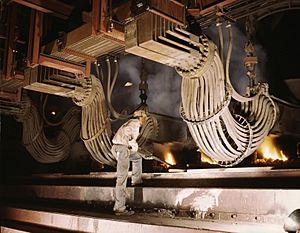Smelting facts for kids

Smelting is a special process that helps us get useful metals from their natural rocks, called ores. Think of it like baking a cake, but instead of flour and sugar, you're starting with rocky material to get shiny metal! Most metals, like iron, copper, zinc, and silver, are found mixed in with other stuff in ores.
However, gold is a bit different. It's usually found as a pure metal, so it doesn't need to be smelted.
Contents
What is Smelting?
The main part of smelting always involves heating the ore to very high temperatures. Sometimes, a special ingredient called a reducing agent is also used. Common reducing agents are coke or charcoal.
How Smelting Works
Many metal ores are oxides, meaning they have oxygen mixed in with the metal. The heating process, often with a reducing agent, helps to remove this oxygen. This leaves the metal behind.
But the metal isn't perfectly clean yet! To make it purer, something called a flux is added. Limestone is often used as a flux. It helps to clean the metal by grabbing onto the unwanted bits, which then turn into a waste material called slag. The slag can then be easily separated from the clean metal.
Different Metals, Different Smelting
Each metal has its own unique way of being smelted. For example, making iron from its ore is usually done in a huge oven called a blast furnace.
Other metals, like zinc or aluminium, need more than just heat. They also require a process called electrolysis. This uses electricity to separate the metal from its ore.
Smelting Through History
Smelting was super important for early human civilizations. It allowed people to make tools, weapons, and jewelry from metal.
The first signs of copper smelting go way back! People started smelting copper between 5500 and 5000 BC. These ancient smelting sites have been found in places like Pločnik and Belovode in Serbia.
Images for kids
-
Casting bronze ding-tripods, from the Chinese Tiangong Kaiwu encyclopedia by Song Yingxing, published in 1637.
-
A furnace from the Cowles Syndicate in Stoke-upon-Trent, England, in the late 1880s.
See also
 In Spanish: Fundición (metalurgia) para niños
In Spanish: Fundición (metalurgia) para niños



